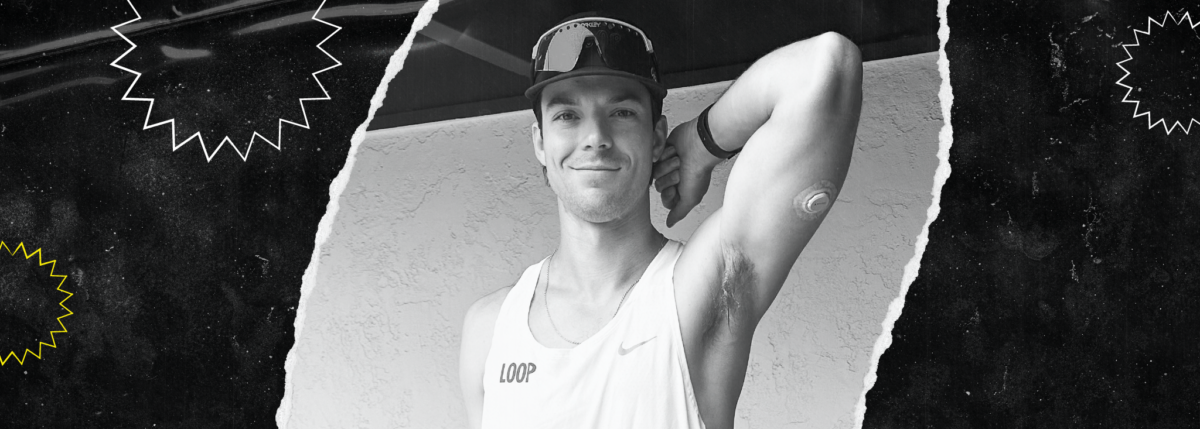Omnipod Helped Me Reduce My A1C by Nearly 10 Percent
Written by: T'ara Smith, MS, Nutrition Education
6 minute read
April 24, 2020
After experiencing diabetic comas, neuropathy, and an A1C of over 17 percent, Prince was able to turn things around with the Omnipod insulin management system to reduce his A1C by nearly 10 percent.
Prince Blue has experienced some of the scariest moments any person with diabetes could have. Since he was diagnosed with type 2 diabetes in 2015 with an A1C of 17.6, he had fallen into two diabetic comas and developed neuropathy in his hand. Nearly five years later, the 37-year-old former police officer is thriving with diabetes with Insulet’s Omnipod DASH Insulin Management System after being introduced to it by his endocrinologist who was wearing one.
In his first year with diabetes, Prince found it difficult to manage through the standard type 2 medication, metformin and other medications such as Trulicity.
“Metformin gave me bad stomach issues like diarrhea and Trulicity made me feel like I had the flu,” said Prince. His doctor wanted to avoid putting him on insulin due to his fear of needles and preferred Prince try managing diabetes with medications and weight management. But in 2016, his doctor had no choice and Prince was prescribed Novolog insulin. Knowing he didn’t like the thought of injecting insulin, Prince opted to not take it.
“I strongly disliked the idea of injecting myself because of the mental aspect of putting a needle inside my body,” said Prince, who says he has needle phobia. “But that wasn’t the only reason. At the time, I was working as a police officer and found myself in situations where I may need to react quickly, and the thought of taking insulin at the worst possible moment was unsettling. I needed an alternative way to get insulin into my body.”
That alternative solution was the V-Go, a 24-hour disposable insulin pump manufactured by Valeritas. However, Prince stopped using it shortly after beginning it because the device didn’t hold enough insulin throughout the day and he didn’t like having to press a button each time he needed a dose. When compared to his experience with Omnipod, Prince loves that his pump can hold up to 200 units of insulin and he can set his basal rate to give him steady doses of insulin throughout the day to keep his blood sugars within range. In addition to that, he enjoys setting his insulin-to-carb ratio to ensure he’s administered the right amount of insulin with every meal.
But his favorite feature of the Omnipod system? It’s tubeless nature. Omnipod is the only tubeless insulin pump on the market. Unlike traditionally-tubed insulin pumps, Omnipod users don’t have to worry about potential snagging on everyday objects. It also has an automatic cannula insertion so users don’t need to see or handle a needle when rotating pump sites on the body.
“When I heard it was Bluetooth and wireless, I zoned in on Omnipod,” said Prince, who calls the product a top-five invention.
Dismantling Misconceptions about Insulin Therapy
Before wearing the Omnipod, Prince believed a common misconception about insulin—that weight gain from insulin therapy hinders one’s progress in managing the disease.
“When my blood sugar was dangerously high, I was losing a lot of weight, and to be honest, I liked the weight loss,” said Prince. “I liked the way my clothes fit, so then I figured, ‘Hey, if I get the weight off, then my diabetes will be better.’ But it was the total opposite. Mentally, I was trying to trick myself into thinking that was a good plan, but I would get disappointed because as soon as I started taking insulin, the weight would come back.”
Fortunately, his doctor gave him some helpful advice and told him though it would take some trial-and-error, he’d make progress.
“Even though I was consistent in the gym, I wasn’t losing the weight I was supposed to lose. But, I was starting to get healthier. My doctor told me to not get discouraged and told me it would be a bit difficult in the beginning to lose weight because I’m on an aggressive insulin therapy program,” said Prince.
While he hasn’t reached his weight goal yet, Prince says wearing the Omnipod has made it easier to focus on achieving it.
“The personal diabetes manager (PDM) takes the guesswork out of how much insulin I need to cover my meals and if my blood glucose is still high, my endocrinologist can adjust my routine for me,” said Prince, who prefers to wear his pod on his stomach. “I love entering specifics into the PDM and it does all of the calculations for you. The extra mental burden is lifted because I don’t have to do all of that math.”
A Major Improvement to His A1C
Nowadays, Prince doesn’t experience many highs and low blood sugars since he wears the Omnipod. If his blood sugar is high after eating a high-carb meal, he can easily administer a correction insulin dose. The same is true for low-blood sugars, he can change his basal settings to avoid a severe hypoglycemia episode.
But the best part of finally having a device that’s helped him overcome his concerns of insulin therapy and get his on track? He’s seen the results in his latest A1C of 8.1—a near 10 percent decrease from his original 17.6 number at the time of his diagnosis.
“I feel so much better now,” said Prince. “The start of my diabetes journey was rough, but things are way different now. I’m in a much healthier place.”
He partly attributes his success to wearing the FreeStyle Libre 14 day system, a continuous glucose monitor (CGM). With the CGM, Prince is able to track in which direction his blood glucose is trending. It makes it easier for him to adjust his pump settings and identify the reasons for those trends.
He also attributes his success to his switch to the Omnipod DASH from the original Omnipod system. Prince suffers from neuropathy in his hand, which made it difficult to press the buttons on the first iteration of the Omnipod PDM. However, when he learned about the Omnipod DASH, he jumped on the opportunity to get it.
“That touchscreen really makes a difference—a real game-changer for me once I started to develop neuropathy,” said Prince. “The PDM seems like a phone, but it’s not. It’s so handy.”
Omnipod Provides an Inclusive Environment for People with T2D
If you’re a person with type 2 diabetes who’s hesitant to start insulin pump therapy, or insulin therapy, in general, Prince says you shouldn’t be. According to him. Omnipod makes people with type 2 diabetes feel welcomed because the company recognizes the shame factor people with type 2 live with.
“When I was first learning about other pump companies, every company seemed like they only catered to people with type 1 diabetes, not type 2,” said Prince. “ I told myself there had to be more people with type 2 in the world, so when I encounter another person with my disease, I feel good. There’s still a stigma on people with type 2 that it’s our fault and we ‘ate’ ourselves into this position. I recently met a woman with type 2 who wears Omnipod, she and I agreed that it didn’t feel like Omnipod was excluding us.”
His experience is evident in the Omnipod’s fast-handling when he experiences a pod malfunction.
“I’m very satisfied with the way they handle my issues,” said Prince. “They ask questions like where was I wearing my pod, how long was it on, and what level my blood sugars were when the pod malfunctioned. Whenever they send me a replacement pod, I get it quickly.”
Still, while Prince is enjoying his experience with Omnipod, he says more work needs to be done to destigmatize the type 2 community, and patients shouldn’t be afraid to ask their doctors to try the device.
“Don’t be afraid to ask about other things that could help you live better with diabetes,” said Prince. “Don’t just let your primary care doctor or endocrinologist give you metformin and stop there. Some doctors are old school, but you have to ask them questions. I did that every time and didn’t just accept metformin, Trulicity, or V-Go. I would ask if there was something new I could try at every appointment. That’s how I knew there was other diabetic equipment out there. There isn’t any harm in asking, I’m proof there isn’t.”
Related Content:
Insulin Pumps for Type 2 Diabetes
This content was created in partnership with Insulet.

Author
T'ara Smith, MS, Nutrition Education
T’ara was diagnosed with type 2 diabetes in July 2017 at the age of 25. Since her diagnosis, she focused her academic studies and career on diabetes awareness and living a full life with it. She’s excited to have joined the Beyond Type 1 team to continue her work. Two years later, T'ara discovered she'd been misdiagnosed with type 2 and actually has latent autoimmune diabetes in adults (LADA). Outside the office, T’ara enjoys going to the movies, visiting parks with her dog, listening to BTS and cooking awesome healthy meals. T’ara holds an MS in nutrition education from American University.
Related Resources

Antoine Gibson is no stranger to overcoming challenges. As a saxophonist and marathon runner living...
Read more

Danica Collins not only prepared for one of the most challenging physical events of her...
Read more

Beyond Type 1 is spotlighting inspiring athletes with type 1 diabetes as they prepare for...
Read more



